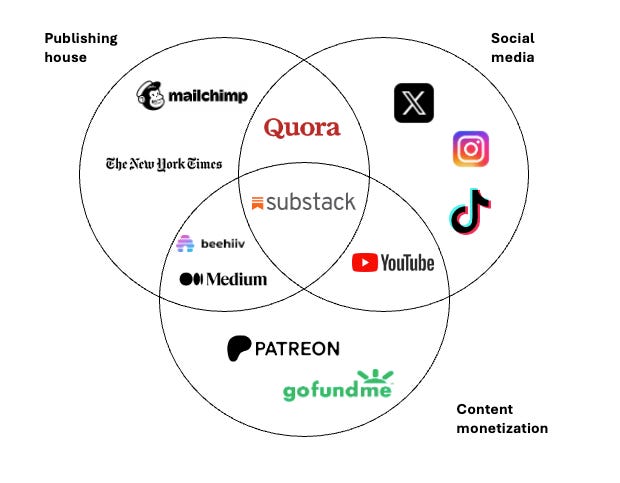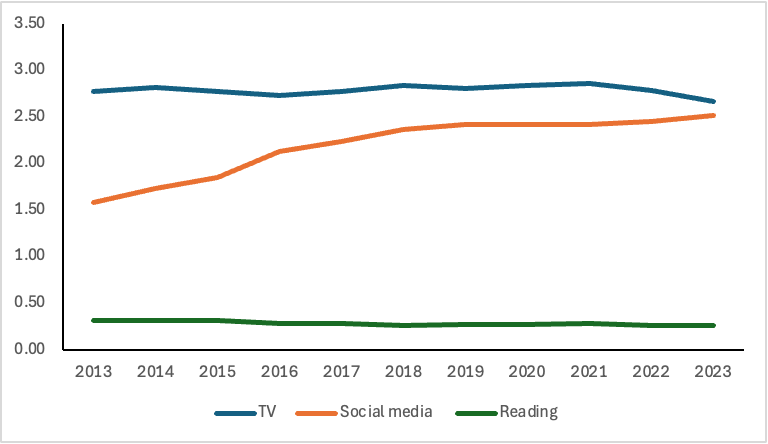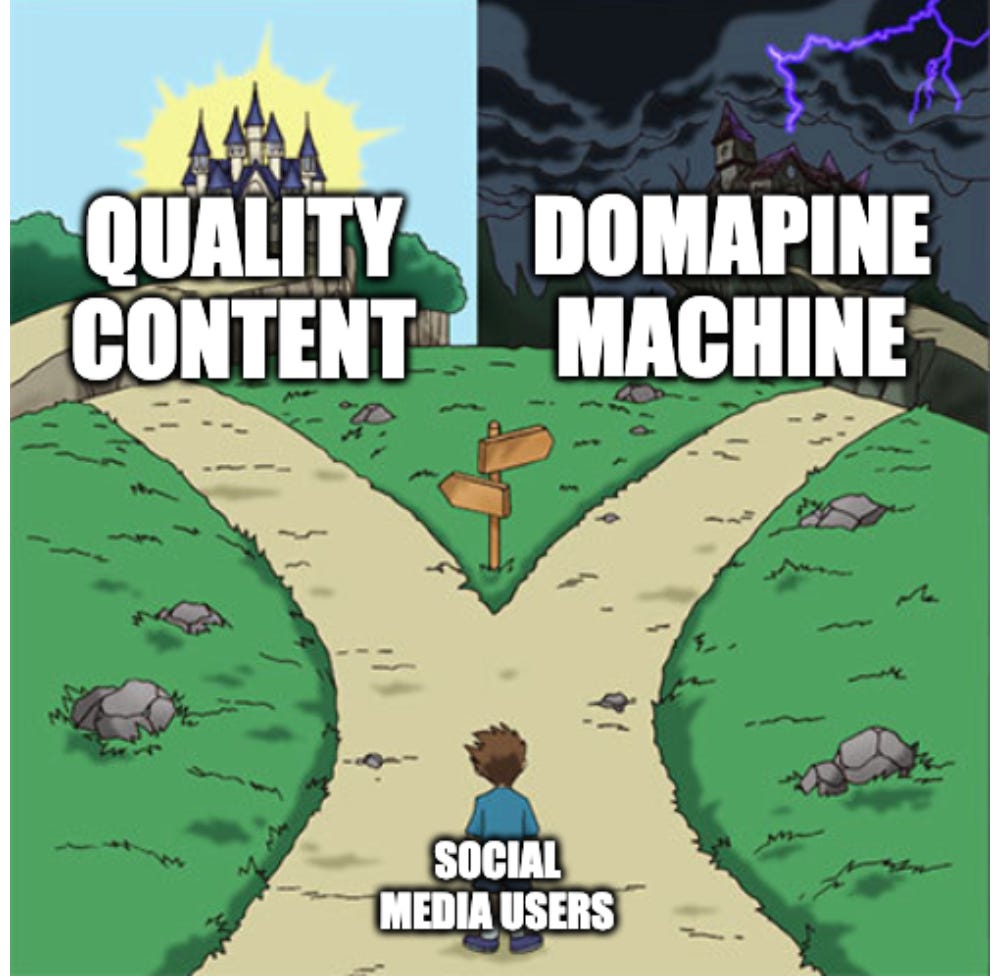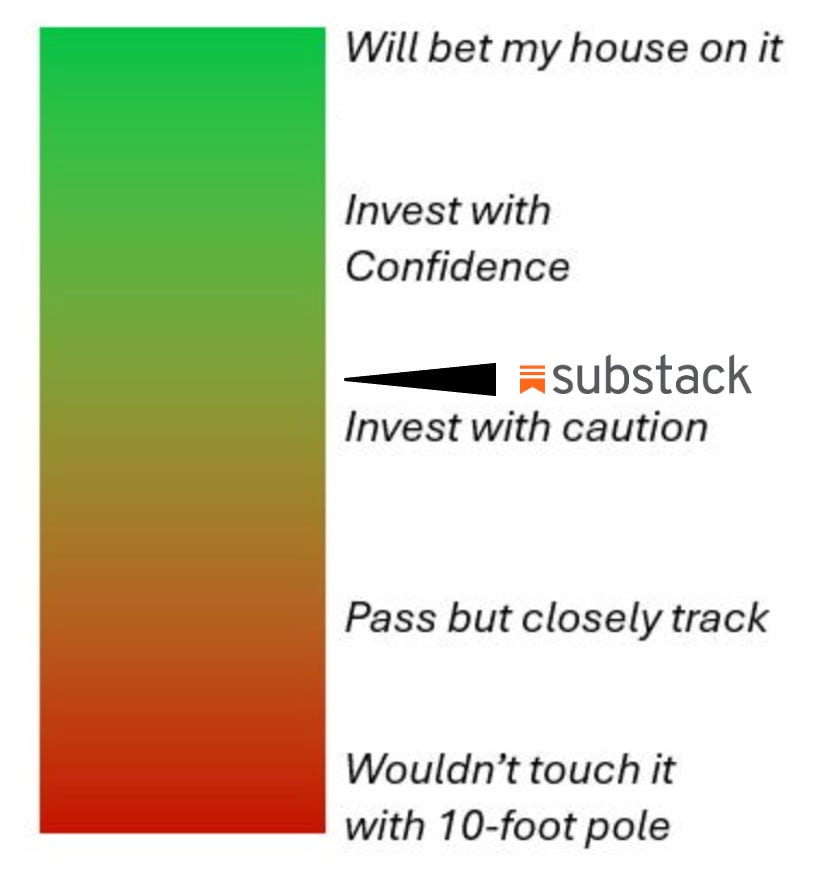Substack: make reading cool again
Social media, content monetization
By the time I realized it, it was too late.
A behaviour has shifted into a habit, a deliberate decision has shifted into a subconscious action.
Once again, the pattern repeats itself— another app has captured my attention and climbed up steadily on my screentime leaderboard.
Over the past months, I have become addicted to Substack. Sure, I spent a lot of time writing articles for my newsletter, but I spent just as much time scrolling through Notes, consuming fascinating business deep dives, captivating poetry, and reflective rants by a community of truly wonderful authors.
However, perhaps for the first time, I don’t feel ashamed.
In fact, this addiction actually feels healthy— like getting really into morning cold plunges or eating quinoa salads. On Substack, I am consuming brilliant content and connecting with a wide range of authors from creatives to university professors.
Luckily for me, I am not alone in this pleasurable addiction. Substack has seen a massive influx of users, with more than 15 million active subscribers signed up last year to reach a total of 35 million subscribers. Lots of readers are switching from X and Instagram due to a distinctly unhealthy addiction, and many writers are looking for another avenue to grow their audience.
Substack, by all measures, is the new cool kid on the block.
However, this represents both an opportunity and also a challenge. With a fast-growing user base, Substack must remain focused on building sustainable connections between readers and writers to retain users. At the same time, Substack’s flashy growth has invited competition from social media giants like X.
Today represents a pivotal moment. Substack will either impress this new influx of users and continue to grow through this network effect, or the users will churn away to seek other platforms and leave Substack in their distant memories. Can Substack differentiate itself from other social media platforms and win a bigger share of people’s precious attention?
Keep reading to find out :)
What is Substack?
Substack is a subscription-based content publishing platform primarily for writers. It provides an email infrastructure for distributing and monetizing content and a mobile App for creators to promote content and connect with their audience. It boasts more than 3M paying subscribers who contributed over $300M to tens of thousands of writers on the platform.
However, the Substack today is almost unrecognizable from its humble origins. To really understand the platform and why it exists, we need to go back in time to 1833.
September 1833 marked an important day in the news industry. The New York Sun began offering its product at one-sixth the price of other newsletters. To compensate for the price drop, it incorporated ads.
Led by the New York Sun, the newsletter industry entered a golden age with the new advertising model. This lasted a while. Well, to be precise, this lasted for almost 180 years, until the Internet Age.
Then, the journalistic giants started dying as advertising dollars and readers’ attention flowed toward Google and Meta, which took over the advertising businesses. Whilst information became readily accessible and democratized, the rise of content farms, clickbaits, and fake news muddied the waters.
Content became abundant, but quality became scarce.
This was precisely the problem that Chris Best and Hamish McKenzie discussed in 2017. Together, they envisioned a better way forward. Substack was founded to keep quality content alive. The founders believed that writers should build direct relationships with their audience, who will gladly pay for the content they love.
From day 1, Substack has been adamant about no advertising. The only revenue model comes from readers paying writers through either donations or subscriptions for premium content.
To align the platform’s incentive with the users’, Substack takes a 10% commission on the subscription fees. This means that in order to grow and generate more revenue, Substack will need to do a better job connecting the right readers to the right writers.
“We believed that direct payments between readers and writers provided a better way forward. With subscriptions, the emphasis is placed on an ongoing trust relationship between reader and writer. The reader – not an advertiser – becomes the primary customer. A writer of a subscription publication can only do well if the reader feels well served – and if they succeed with that, then even a relatively small audience is enough to support a lucrative business.”
In October 2017, the founders built an email delivery tool with a monetization feature. The first guinea pig was Bill Bishop, who had a newsletter called “Sinocism” with 30k+ subscribers. He sent out an email that told his readers his content was going behind a paywall. After a nerve-wracking day, Bill pulled in 6-figure revenues from his subscribers— Substack’s thesis was validated.
Since then, Substack has continued to expand with the vision of building communities and monetizing quality content. In 2022, Substack launched a mobile app. In 2023, Substack built out Notes, a scrolling feed of primarily short-form content by authors, similar to X. During all of this, Substack built out a recommendation algorithm, a direct messaging platform, and writer recommendations. This has marked a notable shift towards a more social-media-like model.
Today, Substack is much more than an email delivery tool. It sits at the intersection between a media publishing house, social media, and a content monetization engine. It has amassed more than 35 million users, raised $80M+ led by investors like a16z, and achieved a valuation of $650M.
The battle for our attention
While Substack has experienced much success and growth, its horizontal expansion has brought competition from all fronts. Beyond the close competitors like Medium and Beehiv, Substack is now picking a fight with social media giants like X.
Fighting with social media companies means fighting for a share of our attention. If history is any indication, Substack is a heavy underdog.
The past decades of social media have emphasized our desire for flashy content and quick serotonin boosts. From Mr. Beast on YouTube to models on Instagram, the content modality has largely been graphics. Reading, on the other hand, is seen as an antiquated, unsexy version of content consumption. Fair enough. Watching a TikTok reel on the world hotdog-eating championship is probably more entertaining than reading Descartes.
Macro statistics on how people spend their leisure time over the past decade show that reading is slowly trending downwards, and social media has skyrocketed.
Interestingly, this graph also shows that our total leisure time has increased substantially over the past decade. The World Economic Forum published a study showing that over the last 150 years, humans have decreased working time from 70 hours a week to around 40 hours, thanks to technological innovations that drove productivity (e.g., assembly lines).
John Maynard Keynes’s prediction of a 15-hour work week by 2030 might still come true with the recent advancements in AI. Human productivity could see another drastic evolution not seen since the Industrial Revolution. If this becomes true, then more leisure time could be dedicated to reading, especially given the negative psychological effects we have witnessed from excessive social media use.
Additionally, even though reading is losing in the attention battle doesn’t mean Substack will lose as well. Substack is not exactly flipping through books the same way that Instagram is not exactly flipping through photo albums. Technology integration has allowed Substack to personalize articles, and the social media aspect taps into our desire for social connection and recognition.
There might be something special about Substack that will allow it to capture a larger slice of our attention pie. After all, there are reasons why its Monthly Active Users grew by 40% in just 6 months.
Maybe, just maybe, Substack is the platform that can make reading cool again.
What I like about Substack
1. People will pursue quality in an increasingly noisy world
Today, there is an excess of low-effort, short-form content meant to produce fleeting giggles and then disappear into the void. Right now, we are eating that content up.
Scrolling through content has become an ingrained habit over the past decade. This is especially true for teenagers, who spend, on average, 2 hours a day scrolling on TikTok. Despite personal anecdotes of social media cleanses, overall usage has steadily trended upwards.
What could change, however, is the type of social media we consume. This could go in one of two directions.
First, people can keep chasing faster, more extreme dopamine releases. As our exposure to rapid-fire digital stimuli increases, we develop a higher threshold for dopamine release. 5 years ago, teenagers would be thrilled to sit down and watch a 30-minute Dude Perfect YouTube video. Now, they would skip through the content because they are not getting a dopamine hit within the first 10 seconds. Content has also gotten more extreme, just take X and OnlyFans as two examples. So, option 1 is we keep going down this path.
The second option is we realize our addiction and do something about it. Currently, around 40% of Americans self-report being addicted to social media, and many of them are switching to more intentional engagement with longer-form content. Early signs of this trend can be seen. Podcasts, for example, have gained significant popularity and have been increasing in length to an average of 41 minutes. Audiobook sales have also been increasing year over year by ~25%.
To be honest, I cannot tell you with confidence that we are heading towards the second path. However, I do firmly believe that change is happening and there is a divergence. Even if the split is 50:50 or even 80:20, more people will be attracted to higher-quality, intellectually stimulating content. Currently, Substack is the go-to platform for those change-seeking individuals
2. Substack enables personalized content discovery across a massive content base
Successful social media shares 2 characteristics: 1) a massively diverse content base, 2) a recommendation engine that pulls the right content in front of the right people.
On Substack, anyone is free to write and publish their content. As a result, writings on Substack become a reflection of the incredibly diverse interests and knowledge of its community, and more broadly, our society at large.
To enable personalization, Substack introduced a novel idea. Sure, it has the traditional recommendation engines like everyone else, which is especially useful for new users. However, the crown jewel of Substack's personalization is the writer recommendations.
Each writer can have a list of their favorite writers in a “recommendation list.” When readers subscribe to a new writer, they are also presented with the option of subscribing to that writer’s recommendations. Substack made it possible for your favorite writer to tell you who inspires them the most and give actually curated and personalized recommendations. Not only does this unlock highly effective content discovery and reduce AI echo chambers, but it also allows writers to build communities with one another.
3. Substack is democratizing publishing houses
The past decades have represented a democratization of content. Entertainment has been taken away from centralized channels and to the hands of individuals. Winning platforms built technologies and tools to make content sharing for individuals as easy as possible. YouTube made anyone a TV star, Instagram made anyone a celebrity, and Substack can make anyone an author.
Substack empowers writers in two ways: content sharing and community building.
The email and monetization engines represent the fundamentals of a publishing house. Substack can effectively distribute your content to your audience through email (and App), with direct monetization mechanisms. Importantly, Substack’s design eliminates lock-in risk, as writers can take their email list and switch off the platform whenever they want. This means, Substack is constantly motivated to provide more value to authors than the 10% commission they charge.
This is where community building comes into play. Unlike publishing houses that offer limited help for connecting with your audience, Substack has been pushing hard for writer-reader engagement. The features of writer DMs, mutual recommendations, and subscriber group chats build a level of camaraderie between writers and readers that has never been witnessed before.
4. Substack makes “intellect” a subcategory of micro-influencers
Everyone is trying to be an influencer. Previously, being extremely extroverted, energetic, and a high tolerance for embarrassment was key in a video-based world (e.g., YouTube, TikTok, OnlyFans). Today, Substack has created a new category of influencers based on intellect.
Writers are directly monetizing pieces of writing that show their knowledge or expertise in something, whether it is discussing industry trends, providing parenting tips, or dissecting the newest fashion trends. Substack now creates a way for millions of knowledgeable individuals not interested in being in front of a camera to also become influencers and live the entrepreneurial lifestyle.
It is incredible to see how much writers can make on Substack. The top 10 newsletters generated more than $25 million in annual subscription revenue in 2022, which has been growing year after year. This means, as the platform matures, more people could make a living by becoming a Substack writer.
As centralized entities become democratized, as individualism becomes the new norm, and as AI displaces traditional jobs, the role of influencers will become greater and greater in our society— so, why not make writers a part of this journey?
What my concerns are
1. Reading is the underdog that might never come back
Historically, writing is the easiest way to transfer, communicate, and preserve knowledge. Today, that notion no longer holds true.
For entertainment specifically, written work has been completely taken over. Only 50% of Americans read a book in the past year, a number that has been drastically reducing since the 2000s as entertainment became readily available through the devices in our pockets.
Substackers would say, well, we are not exactly competing for entertainment. The platform promotes high-quality written work that is intended for a different audience than the teenagers scrolling on Instagram Reels.
However, high-quality content is also getting popularized through other formats. Podcasts, especially, have been increasing in length and depth, and have shown extraordinary growth due to their ease of access and diverse and quality content. With GenAI like Sora playing in the video space, quality content can be transformed into video form, which may capture more attention from the audience.
Despite my hopeful optimism, reading might just never come back.
2. Content subscriptions are popularized across social media platforms
The magic of Substack is the ability for readers to build a direct relationship with the writers through subscriptions, creating a sense of community.
However, other social media platforms have been mimicking this model. Instagram and X both launched subscriber features where users can pay for exclusive content. In addition to subscription-native platforms like Patreon, this new business model is no longer a novel idea.
With that said, traditional social media has struggled with the subscription feature. For example, while Elon Musk has 220M followers on X, his subscriber count is only around 50k. Whilst Onlyfans and Patreon have shown a lot of success, the type of content offered is substantially different than Substack.
So, the good news for Substack is that it still maintains its niche of subscription-based written content. The bad news is that other platforms are eyeing the subscription model, and the opportunity for horizontal expansion may be highly competitive.
3. Rapid growth can come at the expense of core value erosion
While Substack has shown significant growth over the past years, the platform has also changed. On my Notes feed, there is a notable decrease in meaningful content discussions and an increase in “how to grow followers” or “sub for sub” type posts.
This is an unhealthy, but natural journey that most social media platforms go through. As an influx of new users arrives, content creators become eager to convert them into their subscribers and grow their social “clout.” In a world where follower count has become its own currency, greed often takes over.
For Substack, this is particularly dangerous. If quality gives way to a status battle for subscriber count, then writers will spend more time attracting new subscribers than writing content and building communities. If this happens, then the main value proposition of the platform erodes.
When new users join, they no longer see a vibrant community filled with intellectual thought exchange, but instead, they see the 2014 Instagram era of “follow-for-follow.”
It is critical that Substack manages its growth responsibly and remains true to its core value proposition of building genuine connections between readers and writers.
4. Unclear path to liquidity
From a VC perspective, Substack is a tough company to exit. Chris Best has said publicly that he will not sell, because Substack has a principled difference with many of its potential acquirers (e.g., social media giants).
While Substack can go public, it still lacks the steady maturity a public company is expected to demonstrate. A shifted focus on profitability rather than community building would also steer the company away from its core mission.
Final thoughts and recommendations
I like to evaluate companies on 4 key criteria: runway for growth, ability to execute, product-market fit, and defensibility.
Runway for growth: 3/5. As content floods our social media and consumes our daily lives, people will (hopefully) begin to seek quality over quantity. Substack has been benefiting from the initial tailwinds of this trend with impressive user growth over the past few years. Although I expect this trend to continue, quality content in audio and video forms may limit Substack to written content only.
Ability to execute: 3/5. The Substack team has been brilliant in building out the initial platform, emphasizing the importance of the reader-writer connection by aligning business incentives with the users’. However, managing sustainable growth will require different skill sets in the management team.
Product-Market Fit: 2.5/5. As people seek to become entrepreneurial, Substack offers an opportunity to become independent micro-influencers through knowledge sharing. However, it is unclear if written content will meaningfully engage audiences, especially as other forms become easier to create with AI.
Defensibility: 4/5. Substack has established itself as the leader of email engines for written content, especially with Notes acting as a community platform to retain users. Others may seek to challenge it, but so far have limited success.
Overall score: 6/10 (Invest with caution)
As a writer, I love Substack.
I genuinely think it is an incredible platform that has gathered many brilliant minds sharing fascinating knowledge through beautiful writing. What I said in the intro is true— I’ve been using the platform more and more every day.
From an investor’s perspective, I still like the platform but I see some ceilings to its growth.
I believe that Substack has found its niche— a platform focused on creating quality content and building genuine relationships between readers and writers. This is something that the world needs, especially in one that is becoming increasingly noisy.
However, I am yet to be convinced by Substack’s vision of expanding to new verticals like audio and video. It will face fierce competition from others that are more entrenched, more capitalized, and with more users. It will be a difficult battle to win and will set lots of dollars on fire.
I believe in Substack’s vision, I want it to succeed, and I believe it will be the go-to player for its niche. However, will it reach the scale of Instagram or X? I have a hard time seeing that roadmap.
I suppose only time will tell.
In the meantime, let’s build a community on Substack and support its growth! Let me know your thoughts about Substack and how you think it will perform in comments below :)







I really enjoyed this post.
"People will pursue quality in an increasingly noisy world" is exactly what first brought me and now keeps me here.
Thank you for sharing!
What I admire about Substack is its built-in product-led growth. As a writer, you bring your initial audience—via social or past newsletters. And Substack boosting engagement through recommendations and in app feed and notifications.